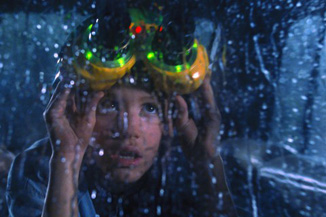The 400-Word Review: Jurassic Park 3D
By Sean Collier
April 7, 2013
BoxOfficeProphets.com

Under closer scrutiny, though, there are two reasons to bother pushing this boulder up the hill. So continue reading, if you don’t mind. (Again: only 400 words.)
First, it’s worth reiterating that Jurassic Park, for all its hype and sequel-ization, is still underrated. An adventure classic on par with anything in the Spielberg oeuvre, the film’s proto-CGI is dated, but the subject — the relentless clash between technological progress and the violence of reality — is evergreen. As are memorable performances by Jeff Goldblum, Laura Dern, Sam Neill, Samuel L. Jackson, Wayne Knight and Richard Attenborough.
Mostly, it’s remarkable, imaginative fun. And the 3-D re-release of the film has successfully brought the classic back into theaters nationwide; for that, it is to be commended.
Secondly — and here’s the important thing — I can’t stress enough how utterly pointless the 3-D conversion is. I’m not sure who in Hollywood is unaware of this — most likely, the people who would like to make a great deal of money — but unless you shoot a movie in 3-D, it won’t look good in 3-D. Over 100 years of film history have taught directors to do things a certain way, and everything about that methodology is built for two dimensions.
It’s the same reason why even movies shot in 3-D often fall flat; nothing about the way we make movies is naturally built for the format, so it takes an incredibly dedicated and focused director — James Cameron with Avatar or Sam Raimi with the recent Oz film are two examples — to make worthy use of the new technology. In general, it adds nothing other than the constant knowledge that you’re wearing an uncomfortable pair of glasses — which, for many, pulls them out of the spell of the cinema.
Those glasses, by the way, are tinted. So unless a film is artificially bright — see the aforementioned, or any of the fine 3-D Pixar films — the picture gets dimmer. So Jurassic Park 3D is Jurassic Park, but harder to see. I’d never discourage anyone from buying a ticket to see this classic, and it’s good enough to overlook the drawbacks. But make no mistake: the glasses add absolutely nothing to the experience.
Sean Collier is the Associate Editor of Pittsburgh Magazine and a member of the Broadcast Film Critics Association. Read more from Sean at pittsburghmagazine.com/afterdark